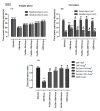Phytochemical Analysis, In Vitro Anticholinesterase, Antioxidant Activity and In Vivo Nootropic Effect of Ferula ammoniacum (Dorema ammoniacum) D. Don. in Scopolamine-Induced Memory Impairment in Mice
- PMID: 33669503
- PMCID: PMC7922987
- DOI: 10.3390/brainsci11020259
Phytochemical Analysis, In Vitro Anticholinesterase, Antioxidant Activity and In Vivo Nootropic Effect of Ferula ammoniacum (Dorema ammoniacum) D. Don. in Scopolamine-Induced Memory Impairment in Mice
Abstract
Background: Ferula ammoniacum (D. Don) is one of the endemic medicinal plants that is traditionally used to treat a number of diseases. Although the plant has been used to enhance memory, the investigational evidence supporting the nootropic effect was unsubstantial. Hence, the rationale for this study was to assess the potential beneficial effect of F. ammoniacum seed extracts on learning and memory in mice.
Methods: The powdered plant samples (aerial parts) were subjected to extraction ad fractionation. Among the extracts, crude and ethyl acetate extracts were screened for major phytochemicals through HPLC analysis. All the extracts were evaluated for the in vitro anticholinesterase (AChE and BChE) and antioxidant potentials. Among the extracts the active fraction was further assessed for improving learning and memory in mice using behavioural tests like Y-maze and novel object recognition test (NORT) using standard protocols. After behavioural tests, all the animals were sacrificed and brains tissues were assessed for the ex vivo anticholinesterase and antioxidant potentials.
Results: Phytochemicals like chlorogenic acid, quercetin, mandelic acid, phloroglucinol, hydroxy benzoic acid, malic acid, epigallocatechin gallate, ellagic acid, rutin, and pyrogallol were identified in crude methanolic extract (Fa.Met) and ethyl acetate fraction (Fa.EtAc) through HPLC. Fa.EtAc and Fa.Chf extracts more potently inhibited AChE and BChE with IC50 values of 40 and 43 µg/mL, and 41 and 42 µg/mL, respectively. Similarly highest free radical scavenging potential was exhibited by Fa.EtAc fraction against DPPH (IC50 = 100 µg/mL) and ABTS (IC50 = 120 µg/mL). The extract doses, 100 and 200 mg/kg body weight significantly (p < 0.01) improved the short-term memory by increasing the percent spontaneous alternation in the Y-maze test along with increasing discrimination index in the NORT that clearly indicated the enhancement in the recognition memory of mice.
Conclusion: The extracts more potently scavenged the tested free radicals, exhibited anticholinesterase activities, improved the learning abilities and reduced the memory impairment induced by scopolamine in mice model thus suggesting that these extracts could be effectively used for the management of oxidative stress, neurodegenerative diseases and memory loss.
Keywords: ABTS; Alzheimer’s disease; DPPH; Dorema ammoniacum (D. Don); Ferula ammoniacum (D. Don); HPLC; NORT; Y-Maze; cholinesterases (AChE and BChE).
Conflict of interest statement
The authors declare that they have no conflict of interests.
Figures









References
-
- World Health Organization . The World Health Report 2001: Mental Health: New Understanding, New Hope. WHO; Geneva, Switzerland: 2001.
-
- Thakur A.K., Kamboj P., Goswami K., Ahuja K. Pathophysiology and management of Alzheimer’s disease: An overview. J. Anal. Pharm. Res. 2018;7 doi: 10.15406/japlr.2018.07.00230. - DOI
-
- Ortner M., Stange M., Schneider H., Schroeder C., Buerger K., Müller C., Dorn B., Goldhardt O., Diehl-Schmid J., Förstl H., et al. Serum Concentrations of Cholinesterase Inhibitors in Patients with Alzheimer’s Dementia Are Frequently Below the Recommended Levels. Front. Pharmacol. 2020;11 doi: 10.3389/fphar.2020.00691. - DOI - PMC - PubMed
LinkOut - more resources
Full Text Sources
Other Literature Sources
Miscellaneous

